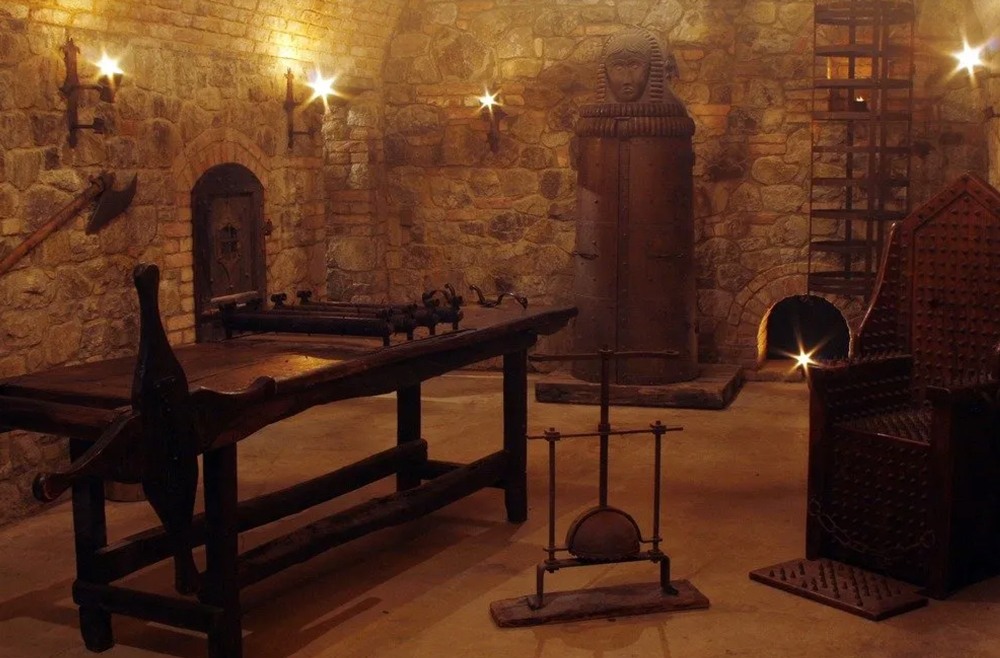
The Torture Chamber
♦ Iron Maiden ♦ The Rack ♦ Hanging Cage ♦ Prison Cells ♦ Spike Chair ♦ Triangle ♦ Cranium Crusher ♦ Pit ♦
“Adjacent to the armaments room is the torture chamber, which has three prison cells to complement the oubliette in the armaments room. Virtually all castles had a special room like this for entertaining unwanted guests. The genesis of Castello di Amorosa’s torture chamber has its root in happenstance. I was walking through the town of Arezzo near Siena one day and passed through it’s beautiful old center, which has many well-respected antique shops. On this particular day, one of the stores had an iron maiden of solid bronze for sale. At first I was intrigued by the frown on the face of the woman depicted on the outside of the device. Then, as I looked more closely, I became captivated by the attention to details that had gone into creating the horrible instrument. This quickly sparked ideas about including a torture chamber at the castle with the iron maiden as its centerpiece. Inspired, I brought the piece and arranged for shipping it to California.
Accomplished blacksmith Giorgio Mariani and I meditated on this uncomfortable truth as we fabricated the rest of the pieces in the torture chamber, basing their designs on numerous photographs, measurements and firsthand inspections of actual devices. The replicas we created include a cranium crusher, a spiked chair, a hanging cage, and a stretching rack, all made of hand-forged iron and centuries-old wood to better approximate the real things.
Virtually all Castles in Europe had prisons and torture chambers. In Venice, the Palazzo Ducale had its own torture chamber, which was of such importance that renovations started in 1507, so that the chamber walls could be kept strong and secure. Typically the medieval torture chamber was windowless and often underground, it was lit by a few candles and was specifically designed to induce “horror, dread and despair”. Historically, torture chambers were located in royal palaces, in Castles of the nobility and buildings belonging to the church. They often featured secret trap-doors which could be activated to throw victims into dark dungeons where they remained and eventually died. Sometimes dungeons under the trap-doors included pits of water where the victim was thrown to drown after a lengthy torture session in the chamber.
Walls were often constructed so thick that the screams of the victims could not penetrate them. The mere presence of the torture chamber was used as a form of intimidation and coercion. The victims were first shown the chamber and if they confessed they would not be tortured inside it. Take the tour and you’ll see a bevy of medieval torture weapons including the original Iron Maiden or The, “Virgin of Nuremberg”.”

Explore The Torture Chamber w/ Castle Owner Dario Sattui Below
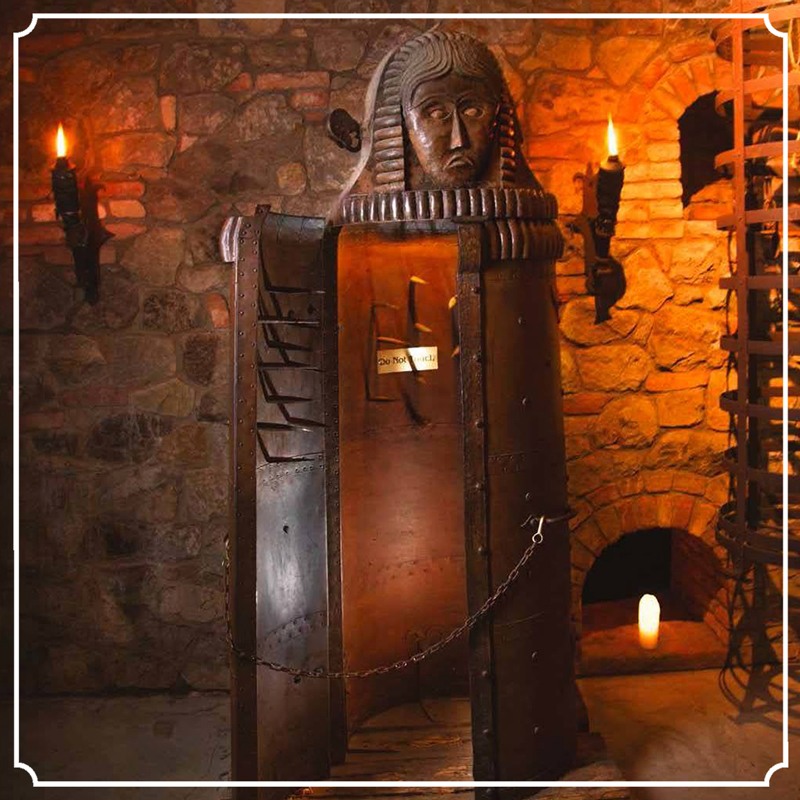
Iron Maiden – The Virgin of Nuremberg
An original Iron Maiden or The, “Virgin of Nuremberg”. The iron maiden is a torture device, consisting of a solid iron cabinet with a hinged front and spike-covered interior, sufficiently tall to enclose a human being. Considered to be one of the most excruciating devices made for torture. Imported from the town of Arezzo near Siena. The spikes on the inside of the iron maiden were not designed to kill immediately but rather to pierce non-vital organs, causing a prolonged and painful death for the unlucky prisoner it embraced.
The classic “Iron Maiden” design consists of a sarcophagus, feminine in appearance, 7 feet high, with a Virgin Mary placed on top. People placed inside could suffer from both claustrophobia and the horrible pain of punctures from spikes. The points stab the arms, legs, stomach, eyes, shoulders and buttocks, all at once.
The mechanism of operating it was quite simple. It had two doors that could be opened and shut. The victim was forced to get inside which was more like a standing coffin with the difference that it had sharp spikes on the inside.
Iron Maiden Facts
- Spikes were rather short, meaning the victim would bleed out over time due to smaller wounds.
- The function of Iron Maidens closing by themselves is considered to be a myth.
- The first account of Iron Maiden use was by the Spartan tyrant Nabis using a similar device around 200 B.C. for extortion and murder.
- The Abbasid vizier Ibn al-Zayyat is said to have created a “wooden oven-like chest that had iron spikes” for torture, which would ironically be used during his own imprisonment and execution in 847.
- The device is similar to another medieval torture device, the Brazen Bull, which traps prisoners inside an iron bull while a fire is lit below the bull.
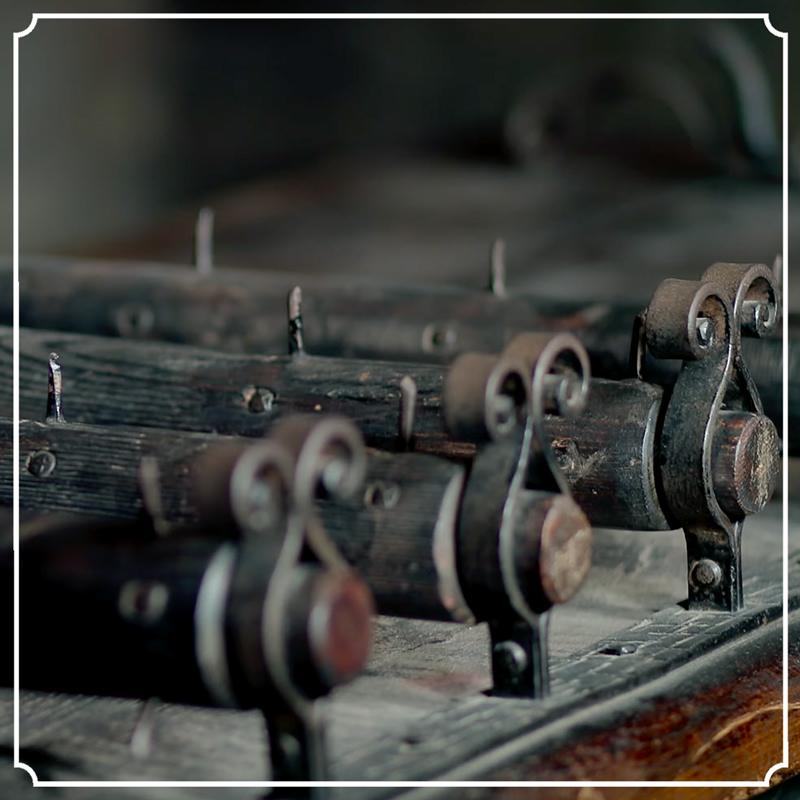
The Rack
The rack is a torture device consisting of a rectangular, usually wooden frame, slightly raised from the ground, with a roller at one or both ends. The accuracy and ease of the rack’s design made it the most commonly-used torture instrument of its day. The victim’s ankles were fastened to one roller and the wrists are chained to the other. Slowly increasing the strain on the prisoner’s shoulders, hips, knees, and elbows and causing excruciating pain. By means of pulleys and levers, this roller could be rotated on its own axis, thus straining the ropes until the sufferer’s joints were dislocated and eventually separated. Another method for putting pressure upon prisoners was to force them to watch someone else being subjected to the rack.
The rack was created by British Constable John Exeter in 1447, for the torture of prisoners of the Tower of London. The advantage to this torture method was its extremely precise control over the impact of pain. The tension could be increased and enhanced by twisting the victim’s joints.
The Rack Facts
- The Rack features 2 inch nails
- It was first mentioned as a form of punishment at the beginning of the XIII century in the contract between Smolensk and Riga (1229)

The Armchair of Inquiries
The Armchair of Inquiries or The Iron Chair were both incredibly similar torture devices originating in Europe’s Middle Ages. The later was used until the late 1800’s in Europe, and other parts of the world. It is known by several names: Chinese Torture Chair, Armchair of Inquiries, Torture Chair, Iron Chair, Judas Chair, Chair of Torturean’s. It’s primary strength lied in the psychological fear it caused its victims. It was common practice to coerce a confession by forcing a victim to watch someone else be tortured with the chair. The number of spikes in a chair would range from 500 – 1,500. A victim would be seated on the chair, wrists restrained, either by straps or two bars that would push the arms against the arm rests. Sometimes weights would be placed on the victim’s thighs or feet. Torture would typically continue for hours, if not days. The chair was the ideal intimidation tactic for obtaining needed information for hundreds of years. In Nuremberg and Fegensburge, preliminary investigations were carried out in these chairs until 1846.
The Armchair of Inquiries
- The Armchair of Inquiries” was successfully utilized in the Middle Ages, and into the 20th century.
- The first victim of the chair was Jean Calas of Toulouse, France, in 1762.
- A fire could be kindled under the chair which turned the chair into a furnace. Spikes would be heated to a temperature of 100oC, leaving behind deep wounds and burns of the fourth degree.
- The model of the chair was repeatedly modified, new torturous details being added in support.
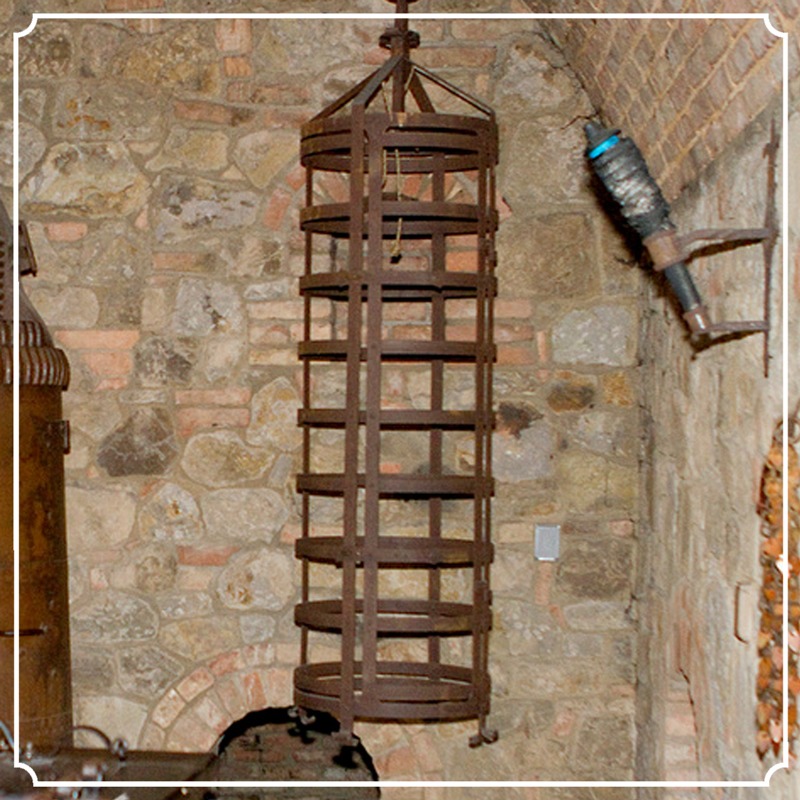
Hanging Cage
Cages were typically used in medieval Castles to keep prisoners put. Many medieval cages were used for Gibbeting, which uses the cage for dead or dying bodies of criminals to hang on public display to deter other existing or potential criminals. Occasionally, the cage was also used as a method of execution, with the criminal being left to die of exposure, thirst and/or starvation. Both of these methods were exhibited in medieval Castles. The sight and smell of decaying corpses was offensive and regarded as “pestilential”, so it was seen as a threat to public health.
The cell could be made from metal or wood, and came with additional design options. Sometimes the distance between the bottom and top bars of the cell was quite large, and the prisoner would be under constant stress, afraid the bars would break and that he would fall. There was also the railway track model, which copied the shape of the human body.
Hanging Cage Facts
- Bodies were sometimes coated in tar or bound in chains, so that public display would be prolonged.
- Gibbeting was one of the methods said by Cassius Dio to have been used by Boudica’s army in the massacre of Roman settlers in the destruction of Camulodunum (Colchester), Londinium (London) and Verulamium (St. Albans) in AD 60–61.
- There is a hanging cage on display at the main gate to Corciano, Province of Perugia, Italy.
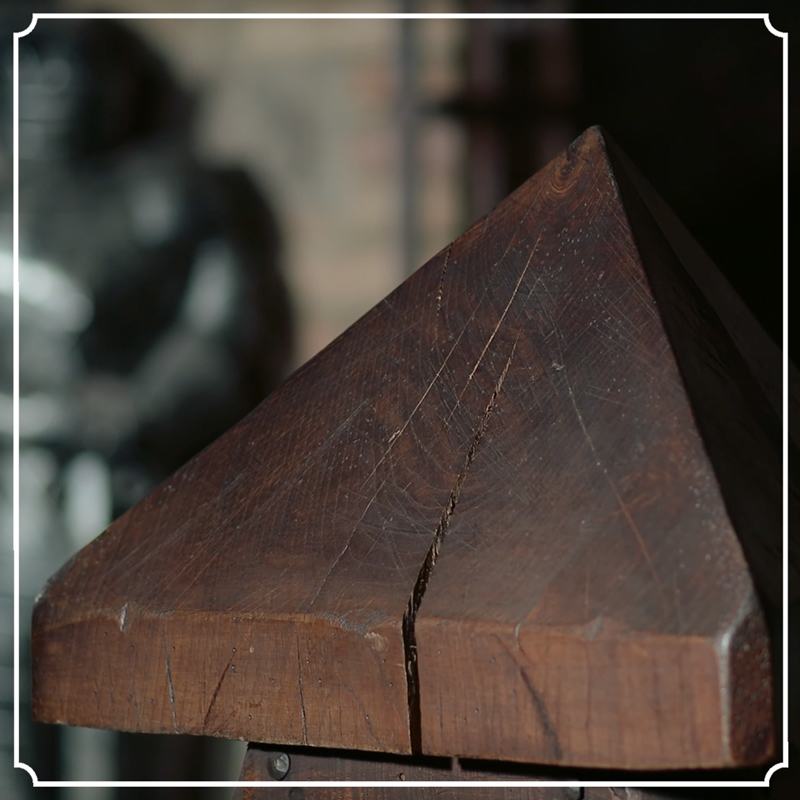
Judas Cradle
Among all our medieval weapons this might cause the most pain. A torture device by which the suspended victim’s orifice was slowly impaled on and stretched by the pyramidal tip of the ‘seat’. The first variation of Judas Cradle was a triangular device Spanish donkey or cavaletto squarciapalle with one end of the triangle pointing upward, mounted on a sawhorse-like support.
Judas Cradle is one of the most sophisticated of the Spanish Inquisition’s inventions. Ippolito Marsilli designed and built this torture instrument. A heavy wooden pyramid that rises up on all fours, like a chair. With the aid of rope and gears, the prisoner was hung naked and slowly lowered directly onto the surface of the point. The torturers used the natural force of gravity to affect the most sensitive area of the human body. The form of the device is designed so that the most painful suffering is delivered to the victim from the braces.
Judas Cradle Facts
- Used in the early modern period.
- Used heavily in the Spanish Inquisition.
- The victim was often carried through town in the cradle, often in conjunction with tarring and feathering.
- Originally considered humane and was only intended to disturb sleep.
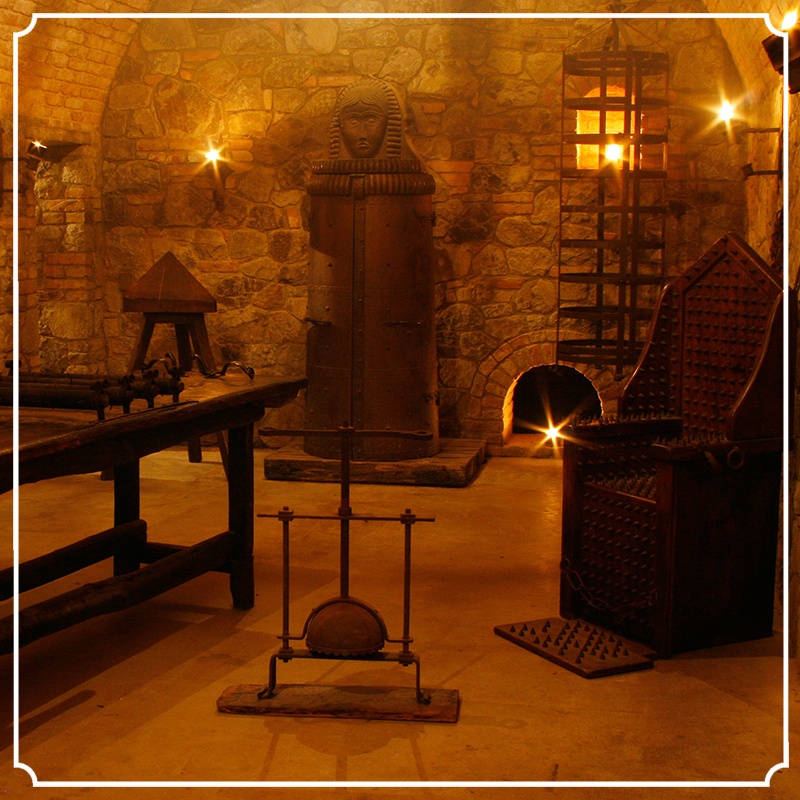
Cranium Crusher
This metal device featured a plate that sat below the victim’s jaw, which was connected by a frame to the head cap. As the torturer slowly twisted the handle, the gap between the head cap and plate decreased, crushing the skull, including the teeth, mandible and facial bones, and ultimately inducing death. Even if the torturer stopped before death, permanent damage to the facial muscles and structure would have occurred. The victim’s head would slowly be crushed, killing the victim, but not before the victim’s jaw had been crushed, and their eyes may have possibly extruded from their sockets.
The chin of victim was placed above the bottom bar, and the uppercap lowered by the turning of screws. The teeth and then the jawbones broke till the cracking of the skull bone. Modern versions are filled with soft materials which leave no trace on the flesh of the victim, who however is ready to collaborate with questioners after a few turning of the screws.
Cranium Crusher Facts
- Used in the Middle Ages.
- Used heavily in the Spanish Inquisition.
- Many variants of this device have existed.
- Some had small containers in front of the eyes, to catch them as they fell out of their sockets.
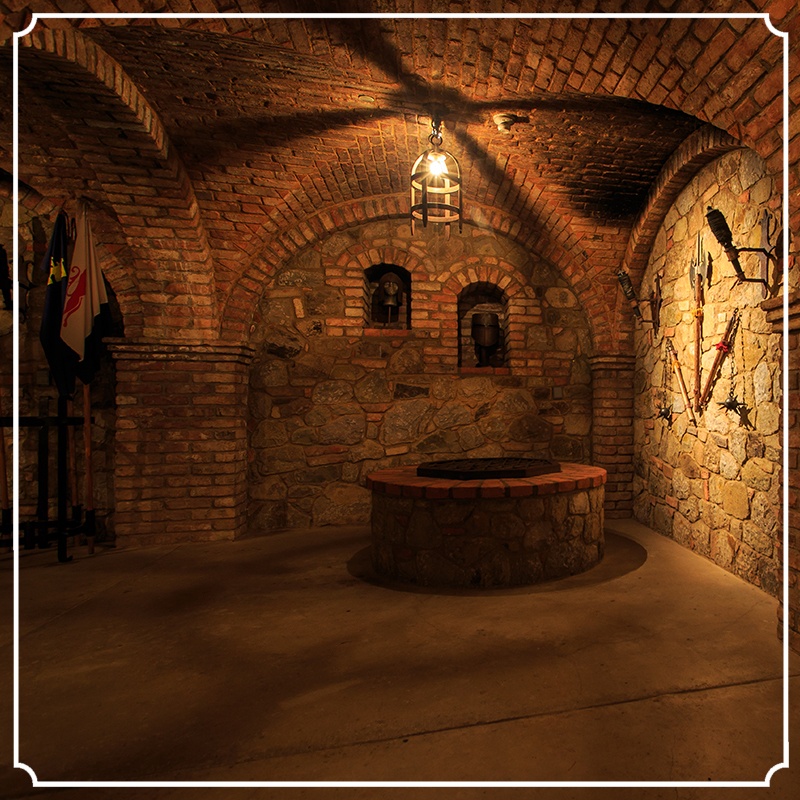
The Pit of Despair
These isolation pits are a classic trap for intruders. Don’t even think about trying to escape! Although the term has a medieval origin, the device was first described by Julius Caesar, in the seventh book of his Commentarii de Bello Gallic. Still scholars claim that the original origins lay with hunters & gathers more than 20,000 years ago. Also known as a trou de loup (French for wolf hole, also commonly referred to as a tiger pit in the East) was a type of booby trap or defensive obstacle. There are several dynamic characteristics with these pits, the first is the determination of indoor or outdoor use of the hole. This is typically determined by the intended role of the prisoner in the pit. Indoor pits typically hold a prisoner, while outdoor pits are suppose to capture and hold a prisoner. These details can significantly change the pits structure and design.
Pit of Despair Facts
- Another variation of the pit is known as Trou de loup.
- Later Roman examples can be seen at Rough Castle on the Antonine Wall in Great Britain.
- Typically pits used as booby traps, will have weapons at the bottom to strike a fatal blow to the victim.
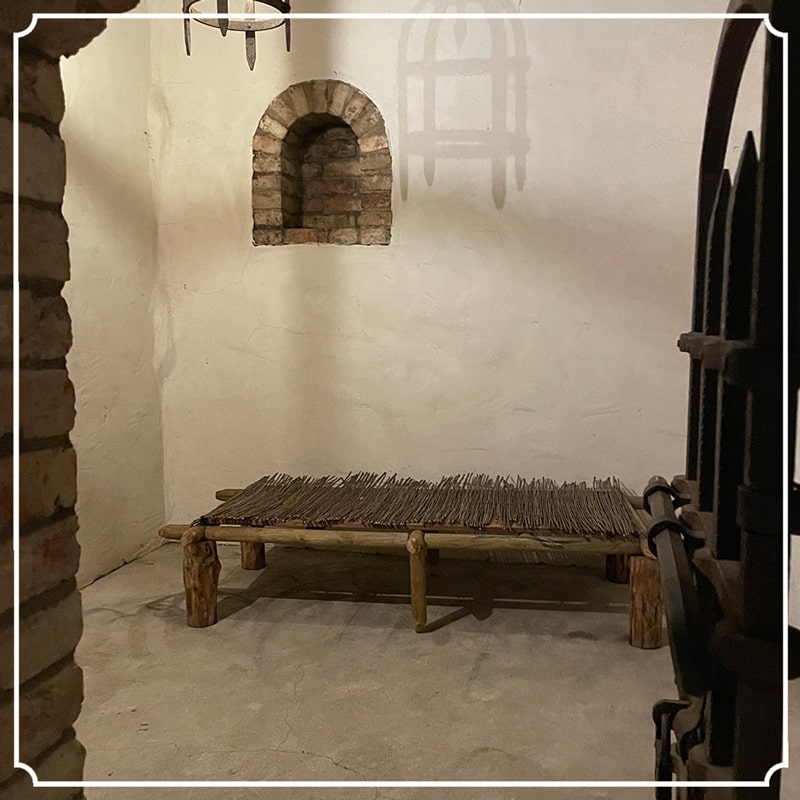
Medieval Prison Cells
We have a total of 3 prison cells in the Dungeon. Strong matts included. Cells in which prisoners are held, were usually underground during the Medieval period. Dungeons are generally associated with medieval castles and the Renaissance period. These cells could be both an instrument of torture and the place where said victims usually ended their days. Cells themselves were very minimal, often devoid from light.
Prison Cell Facts
- Iron collars were often used in cells to further deter escapes, some of these weighed around 35 pounds.
- Prisoners were often left to starve and dehydrate to death.
- One of the first prison cells ever was The Mamertine Prison also known as the Carcere Mamertino, which was a prison with a dungeon located in the Comitium of ancient Rome. It is said to have been built in the 7th century BC.

